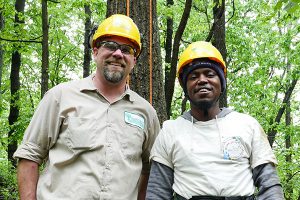Green Jobs, Bright Futures: Workforce development provides entry to natural resources careers

Stream restoration; by Trystan Sill
“I love the outdoors,” says Fallon Jones. “I have a 9-year-old son and just being able to get into an industry where I can show him, not only about the environment, but also that mommy does something to help the planet—that’s just a great aspect for me.”
Jones is a graduate of Work2Live WELL, a new workforce development and skills training program at the Maryland Department of Natural Resources that affords fast-track entry into jobs in aquaculture, boating, commercial fisheries, forestry, restoration, stormwater management and wildlife management.
“I loved being outside a lot, all the training, working on machinery and learning about the environment,” says Antwan Watson, another program graduate.
Partnering with private businesses, nonprofits and universities, the eight-week program provides classroom sessions, hands-on field training and one-on-one mentoring to un- or underemployed adults. The pilot program took place in two locations: Baltimore City, which focused on land resources, and Cambridge, which focused on water resources.
“It’s a pleasure to work with this group and see their excitement about a world they had very little previous exposure to,” says Trystan Sill, program manager. “[This program] lets us foster that special sense of wonder about nature. Even better, we provide connections to careers and introduce a new generation of stewards who better reflect the diversity of our state.”
The program is financed through EARN Maryland, a state-funded program from the Department of Labor, Licensing and Regulation that helps residents find meaningful careers while also helping businesses cultivate the skilled workforce they need. Work2Live WELL uses a holistic approach, teaching technical skills as well as life skills so participants are well prepared for the realities of the workforce.
Each participant is paired with a mentor in the natural resources profession, who they meet with for an hour per day throughout the program.
“Thanks to the mentors, participants leave not only knowing how to do their job but also understanding what is expected in a professional setting and how to fit in with work culture,” adds Sill. “Having this dedicated support and guidance in addition to the training has helped many gain employment.”
The stormwater gap
Polluted stormwater runoff harms many communities, but companies struggle to find skilled workers.
“There’s a huge need for more skilled workers in the stormwater industry, mostly because it’s an emerging field so there isn’t a built-in, experienced labor force,” says Liam O’Meara, president of Environmental Quality Resources.
How did participants learn about the stormwater industry? Enter the Center for Watershed Protection, a nonprofit based in Ellicott City that works to protect, restore and enhance our waterways.
Bryan Seipp, the center’s watershed manager, conducted a one-day training to introduce the world of stormwater to program participants. He began in the classroom and provided an overview of the task at hand, the work that goes into typical projects and industry jobs.
“Not only did the center bring a wealth of stormwater training to the program, they also helped us think through the most effective learning styles,” says Sill. “The more hands-on, the better.”
For the second half of the day, participants visited local projects recently installed by Blue Water Baltimore, another nonprofit. Ashley Traut, senior manager of innovative stormwater projects, joined Seipp to show participants best management practices at Baltimore International Academy, St. Anthony’s Catholic Church and the Natural History Society.

Andre Neal (right) with Paul Mullins of Bartlett Tree Experts; by Stephen Badger
The training demonstrated how the watershed is connected—from a church parking lot to the Chesapeake Bay. Participants learned that stormwater projects are not always massive endeavors—sometimes they are as small as curb cutouts that allow for water flow.
“Work2Live WELL was very well organized and strategic, and complements our training well,” says Seipp. “Participants were introduced to the broad field of natural resources management earlier in the program, including watersheds and runoff. Armed with this foundational knowledge, they then gained in-depth knowledge about stormwater management, where there is a lot of job opportunity.”
Establishing flow
After the one-day training, the center and Civic Works offered the group the opportunity to participate in additional training after they graduated from Work2Live WELL. Seven of the 20 participants attended.
The Center for Watershed Protection began its program a few years ago as one- to two-day technical training for un- and underemployed adults. Initially, the training was very similar to the center’s stormwater management training programs for professionals already working in the industry.
“We quickly realized there was a need to modify and expand the training beyond just the technical aspect to help these participants secure jobs,” says Neely Law, the center’s director of training and education.
With funding from Keith Campbell Foundation, France Merrick and Prince Charitable Trust, and through critical partnerships such as Civic Works and stormwater industry employers, the center’s more in-depth training provides a direct pathway for a sustainable, life-changing career.
So far, four of the seven participants have been hired into stormwater jobs, two are now employed in the natural resources field, and one is still looking for employment.
“These programs are a win-win-win,” adds Law. “Not only do they fill a critical need for the stormwater industry and other employers, they will also help protect natural resources, bolster local economies and change the futures of these young adults.”
“This program has really helped me change my life, and my outlook on the future is hopeful and positive. All the staff really love what they do, and it shows. I hope this program continues far into the future.” -Andre Neal, program graduate
| Work2Live WELL was a success thanks in part to more than 50 partners across Maryland. Baltimore partners included the Center for Watershed Protection, Civic Works, Green Street Academy, the Baltimore City Mayor’s Office of Employment Development and the U.S. Forest Service. Eastern Shore partners included Richardson Maritime Museum, University of Maryland Extension and Wor-Wic Community College. |
Article by Kristen Peterson—Senior Director of Communications at the Hatcher Group. Appears in Vol. 21, No. 4 of the Maryland Natural Resource magazine, fall 2018.


 1-888-373-7888
1-888-373-7888 233733
233733